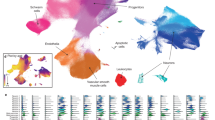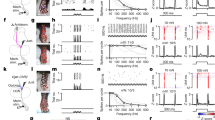Abstract
Dorsal root ganglion (DRG) neurones transmit cutaneous sensory information from the periphery to the spinal cord. Within the dorsal horn of the spinal cord, classes of sensory fibres that are activated by different cutaneous stimuli terminate in separate and highly restricted laminae1–3. Although the developmental events resulting in the laminar organization of sensory afferent terminals have not been defined, it is likely that interactions between surface molecules on DRG and dorsal horn neurones are involved in the generation of afferent synaptic connections. The identification of surface antigens that distinguish functional subclasses of DRG neurones would represent a first step in establishing the existence and nature of such molecules. We report here that monoclonal antibodies directed against carbohydrate differentiation antigens4,5 identify cytoplasmic and cell surface molecules expressed selectively by functional subsets of DRG neurones.
This is a preview of subscription content, access via your institution
Access options
Subscribe to this journal
Receive 51 print issues and online access
$199.00 per year
only $3.90 per issue
Buy this article
- Purchase on Springer Link
- Instant access to full article PDF
Prices may be subject to local taxes which are calculated during checkout
Similar content being viewed by others
References
Brown, A. G. Organization in the Spinal Cord (Springer, Berlin, 1981).
Light, A. R. & Perl, E. R. J. comp. Neurol. 186, 133–150 (1979).
Rethelyi, M. J. comp. Neurol. 172, 511–528 (1977).
Solter, D. & Knowles, B. B. Curr. Top. dev. Biol. 13, 139–165 (1979).
Feizi, T. Trends biochem. Sci. 6, 333–335 (1981).
Shevinsky, L. H., Knowles, B. B., Damjanov, I. & Solter, D. Cell 30, 697–705 (1982).
Kannagi, R. et al. J. biol. Chem. 258, 8934–8942 (1983).
Kannagi, R. et al. EMBO. J. 2, 2355–2361 (1983).
Hokfelt, T., Johansson, O., Ljungdahl, A., Lundberg, J. M. & Schultzberg, M. Nature 284, 515–530 (1980).
Nagy, J. I. & Hunt, S. P. Neuroscience 7, 89–97 (1982).
Dodd, J. et al. Cold Spring Harbor Symp. quant. Biol. 48, 685–695 (1983).
McClung, J. R. & Castro, A.J. Expl Neurol 58, 145–148 (1978).
Nagy, J. I. & Hunt, S. P. J. comp. Neurol. 218, 145–158 (1983).
Brown, A. G., Rose, P. K. & Snow, P. J. J. Physiol., Lond. 272, 779–797 (1977).
Brown, A. G., Fyffe, R. E. W. & Snow, P. J. J. Physiol., Lond. 307, 385–400 (1980).
Raff, M. C. et al. Brain Res. 174, 283–308 (1979).
Lawson, S., Caddy, K. W. T. & Biscoe, T. J. Cell. Tissue Res. 153, 399–413 (1974).
Magnani, J. L. Biochem. Soc. Trans. 12, 543–545 (1984).
Feizi, T. Biochem. Soc. Trans. 12, 545–549 (1984).
Jessell, T. M. & Dodd, J. Phil. Trans. R. Soc. (in the press).
Grabel, L. B., Singer, M. S., Rosen, S. D. & Martin, G. R. Cold Spring Harb. Conf. Cell Proliferation 10, 145–161 (1983).
Shur, B. D. Cold Spring Harb. Conf. Cell Proliferation 10, 185–195 (1983).
Bird, J. M. & Kimber, S. J. Devl Biol. 104, 449–460 (1984).
Edelman, G. M. et al. Cold Spring Harb. Symp. quant. Biol. 48, 515–526 (1983).
Rutishauser, U. Cold Spring Harb. Symp. quant. Biol. 48, 501–514 (1983).
Yamamoto, M., Steinbusch, H. W. M. & Jessell, T. M. J. Cell Biol. 91, 142–154 (1981).
Author information
Authors and Affiliations
Rights and permissions
About this article
Cite this article
Dodd, J., Solter, D. & Jessell, T. Monoclonal antibodies against carbohydrate differentiation antigens identify subsets of primary sensory neurones. Nature 311, 469–472 (1984). https://doi.org/10.1038/311469a0
Received:
Accepted:
Issue Date:
DOI: https://doi.org/10.1038/311469a0
This article is cited by
-
Cofilin dysregulation alters actin turnover in frataxin-deficient neurons
Scientific Reports (2020)
-
Sciatic nerve injury in the adult rat: comparison of effects on oligosaccharide, CGRP and GAP43 immunoreactivity in primary afferents following two types of trauma
Journal of Neurocytology (1996)
-
Transganglionic labelling of primary sensory afferents in the rat lumbar spinal cord: comparison between wheatgerm agglutinin and the I-B4 isolectin fromBandeiraea simplicifolia
Journal of Neurocytology (1994)
-
Substance P, neurofilament, peripherin and SSEA4 immunocytochemistry of human dorsal root ganglion neurons obtained from post-mortem tissue: a quantitative morphometric analysis
Journal of Neurocytology (1994)
-
Differential localization of lectin binding sites and neuropeptides in human dorsal root ganglia
Histochemistry (1994)
Comments
By submitting a comment you agree to abide by our Terms and Community Guidelines. If you find something abusive or that does not comply with our terms or guidelines please flag it as inappropriate.



